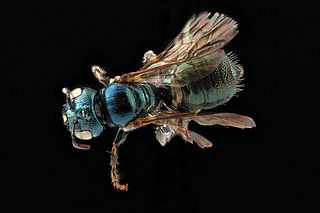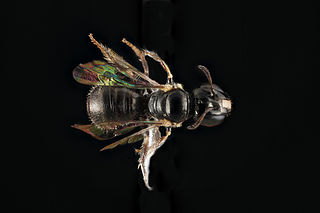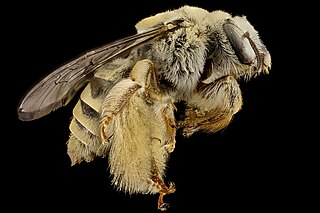
The cosmopolitan bee genus Ceratina, often referred to as small carpenter bees, is the sole lineage of the tribe Ceratinini, and is not closely related to the more familiar carpenter bees. They make nests in dead wood, stems, or pith, and while many are solitary, a number are subsocial, with mothers caring for their larvae, and in a few cases where multiple females are found in a single nest, daughters or sisters may form very small, weakly eusocial colonies. One species is unique for having both social and asocial populations, Ceratina australensis, which exhibits all of the pre-adaptations for successful group living. This species is socially polymorphic with both solitary and social nests collected in sympatry. Social colonies in that species consist of two foundresses, one contributing both foraging and reproductive effort and the second which remains at the nest as a passive guard. Cooperative nesting provides no overt reproductive benefits over solitary nesting in this population, although brood survival tends to be greater in social colonies. Maternal longevity, subsociality and bivoltine nesting phenology in this species favour colony formation, while dispersal habits and offspring longevity may inhibit more frequent social nesting in this and other ceratinines.

Ribes americanum is a North American species of flowering plant in the gooseberry family known as wild black currant, American black currant, and eastern black currant. It is widespread in much of Canada and the northern United States.
Lobelia boykinii is a species of flowering plant in the bellflower family known by the common name Boykin's lobelia. It is native to the eastern United States, where it occurs from Delaware to Florida. There is also a disjunct occurrence in New Hampshire.

Ceratina strenua, the nimble ceratina, is a species of small carpenter bee in the family Apidae. It is found in North America.

Ceratina cobaltina is a species of small carpenter bee in the family Apidae. It is found in Central America.

Ceratina cockerelli is a species of small carpenter bee in the family Apidae. It is found in the Caribbean Sea and North America.
Ceratina nanula is a species of small carpenter bee in the family Apidae. It is found in Central America and North America.

Ceratina arizonensis is a species of small carpenter bee in the family Apidae. It is found in Central America and North America.

Ceratina calcarata, the spurred ceratina, is a species of small carpenter bee in the family Apidae. It is found in eastern North America. This species ranges from Georgia, USA north to Ontario, Canada and east to Nova Scotia, Canada. This bee is a common generalist, native pollinator, it pollinates plants like watermelon and cucumber very effectively. C. calcarata adds to the productivity of a wide range of ecological and agricultural systems due to its wide range and abundance. This small bee is becoming a model organism in the scientific research of social evolution. C. calcarata is the first subsocial bee species to have its genome published, allowing researchers to investigate the evolutionary origins of social behaviour.
Ceratina sequoiae is a species of small carpenter bee in the family Apidae. It is found in North America.
Ceratina dallatorreana is a species of small carpenter bee in the family Apidae. It is found in Africa, Europe and Northern Asia, and North America.

Diadasia rinconis is a species of chimney bee in the family Apidae. It is found in Central America and North America. In the Sonoran Desert, D. rinconis is considered the "cactus bee" as it feeds almost exclusively on a number of Sonoran Desert cactus species, its life cycle revolving around the flowering of the native species of cacti.

Anthophora urbana is a species of anthophorine bee in the family Apidae. It is found in Central America and North America.
The brown-tailed miner bee is a species of miner bee in the family Andrenidae. Another common name for this species the dark-tailed andrena. It is found in North America.
The Piper's miner bee is a species of miner bee in the family Andrenidae. It is found in Central America and North America.
The sad miner bee is a species of miner bee in the family Andrenidae. Another common name for this species is the mournful miner. It is found in North America.

Ceratina acantha is a species of small carpenter bee in the family Apidae. It is found in Central America and North America.
The shiny green miner bee is a species of miner bee in the family Andrenidae. Another common name for this species is the white-winged perdita. It is found in Central America and North America.

Svastra obliqua, the sunflower bee, is a species of long-horned bee in the family Apidae. It is found in Central America and North America.

The Bradley's miner bee is a species of miner bee in the family Andrenidae. Another common name for this species is Bradley's andrena. It is found in North America.












